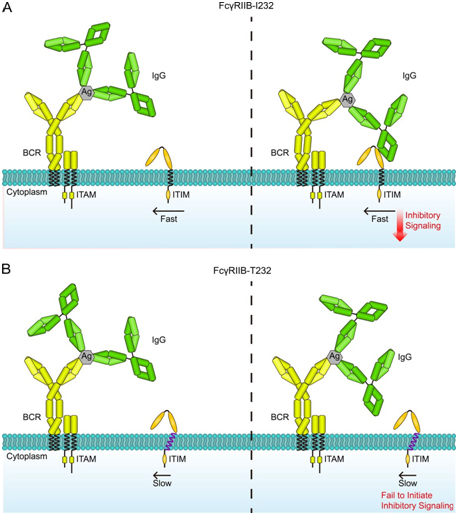Recently, a collaborative research team from Prof. Chenqi Xu, at Shanghai Institute of Biochemistry and Cell Biology, Shanghai Institutes for Biological Sciences (SIBS), Chinese Academy of Sciences (CAS), Prof. Wanli Liu and Prof. Haipeng Gong from Tsinghua University and Prof. Zhanguo Li from Peking University People’s Hospital found that the lupus associated SNP FcgRIIB-T232 has crippled lateral mobility, which will lead to the functional disruption and abnormal activation of B cell.
This work entitled “Impairment on the lateral mobility induced by structural changes underlies the functional deficiency of the lupus-associated polymorphism FcγRIIB-T232” has been published online in The Journal of Experimental Medicine on Oct. 31st, 2016.
In this study, four groups work together, and investigated the function disruptionof FcγRIIB-T232 in a different perspective by combing techniques of high-speed single molecule–tracking, superresolution imaging, molecular dynamics(MD) simulations, and nuclear magnetic resonance(NMR) spectroscopy.By live-cell and single-molecule imaging, they found that FcγRIIB-T232 diffuses significantlyslower than FcγRIIB-I232 on the plasma membrane ofhuman primary B cells as well as monocytes and was significantly less enriched into the microclusters of immune complexes(ICs) after stimulation. Following experiments showed that the rapid lateral mobility is essential for sustainingthe inhibitory function of FcγRIIB. MD simulation and NMR results showed that the crippled lateral mobility ofFcγRIIB-T232 is possibly caused by changes in conformationand orientation of the TM domain of FcγRIIB-T232. The I232T renders the TM helix more bent and more tilted within the membrane with longer TM helix. These structural changes inevitably increasethe cross-sectional area of the TM domain and, thus,shall in turn reduce the lateral mobility of FcγRIIB-T232. This work provide theory basis for the positive correlation between FcγRIIB-T232 and lupus, and can also benefit the personalized therapy, diagnose and prognosis.
This research is founded by the Natural Science Foundation of China(NSFC), Chinese Academy of Sciences and Science and Technology Commission of Shanghai Municipality. The NMR facility in National Center of Protein Science, Shanghai (NCPSS) contribute a lot to the NMR work.
AUTHOR CONTACT
Dr. Chenqi Xu
Institute of Biochemistry and Cell Biology, Shanghai Institutes for Biological Sciences, Chinese Academy of Sciences, Shanghai, China
E-mail: cqxu@sibcb.ac.cn

Fig. The crippled lateral mobility of FcγRIIB-T232 led to its functional deficiency.
 Appendix:
Appendix: